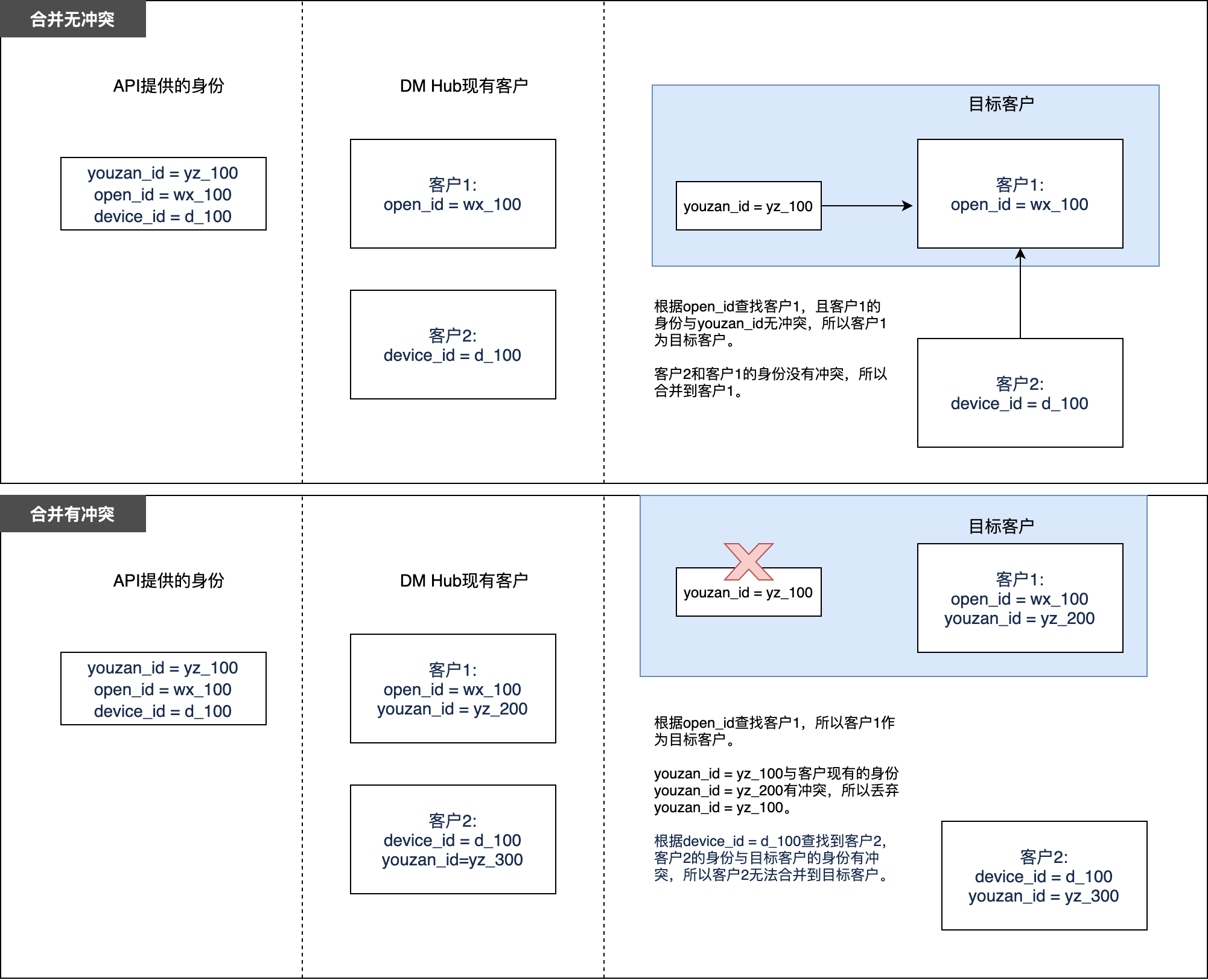Customer Identity
Identity is like our ID card. Once the information is wrong, the data of each channel may be matched incorrectly, or even completely confused. Therefore, before accessing the data of each channel, please make sure to sort out the identity, priority and merge logic of each channel’s customer information.
1.Overview
DM Hub supports access to omni-channel data, such as WeChat fans data, page form data, offline activity data, Tmall order data, web browsing data, and third-party system connection data. When the data of each channel is imported into the DM Hub, system will match the data through identity id to ensure that the data accurately falls on the corresponding customer, such as mobile phone number, email address, WeChat openid, and WeChat unionid can all be unique as an identity type to identify a customer. Recording customer identity mainly has the following two functions: Through cross-channel identity (such as mobile phone number, email), customer information from multiple channels can be integrated to achieve cross-channel customer data connection; external systems can perform CRUD operation (create, retrieve, update, and delete) on specific customers through channel identity information (without recording DM Hub’s customer id).
2.The difference between customer special properties and identity
In the DM Hub, mobile phone numbers and email addresses can be used as customer properties and customer identities. What is the difference between them?
Data acquisition methods are different: mobile phone numbers and email address can be obtained through forms, data docking, import, manual modification, etc.; mobile phone numbers and email address identities only support call interface creation for the time being;
Read and write features: mobile phone number and mailbox properties support modification, but identity modification is temporarily not supported;
Uniqueness: Different customers may have the same mobile phone number or email properties, but they will not have the same mobile phone number or email identity.
Different purposes: mobile phone number and email address properties are mainly used to reach customers, such as sending SMS (email); customer identity is mainly used for customer matching and identification.
When importing customer data, if the file contains "mobile phone number" and "email address", the data will be matched by identity first. When there is no corresponding identity, the mobile phone number or mailbox property will be used for matching.
3.Scenarios for creating customer identities in the system
Binding WeChat service account:automatically import WeChat fans after authorization, and automatically add the fan's WeChat identity openid (if you have applied for the WeChat open platform and bound the official account, there will be unionid as well);
Following the official account:openid (if you have applied for the WeChat open platform and bound the official account, there will be unionid as well)
WeChat environment to submit WeChat Page form:openid
Wechat authorization is performed when accessing the WeChat Page:openid (if you have applied for the Wechat open platform and bound the official account, there will be unionid as well)
Taobao:When importing a Tmall order, the Taobao member name will be automatically used as the Taobao identity
Create a member:After becoming a member, the corresponding customer will automatically generate a membership ID; the member created in the WeChat environment by submitting the membership registration page form created by DM Hub, the corresponding customer will have an openid and mobile phone number in addition to the membership ID.
4.Identity Settings
4.1Function Location
Settings Center-Basic Data-Customer Identity
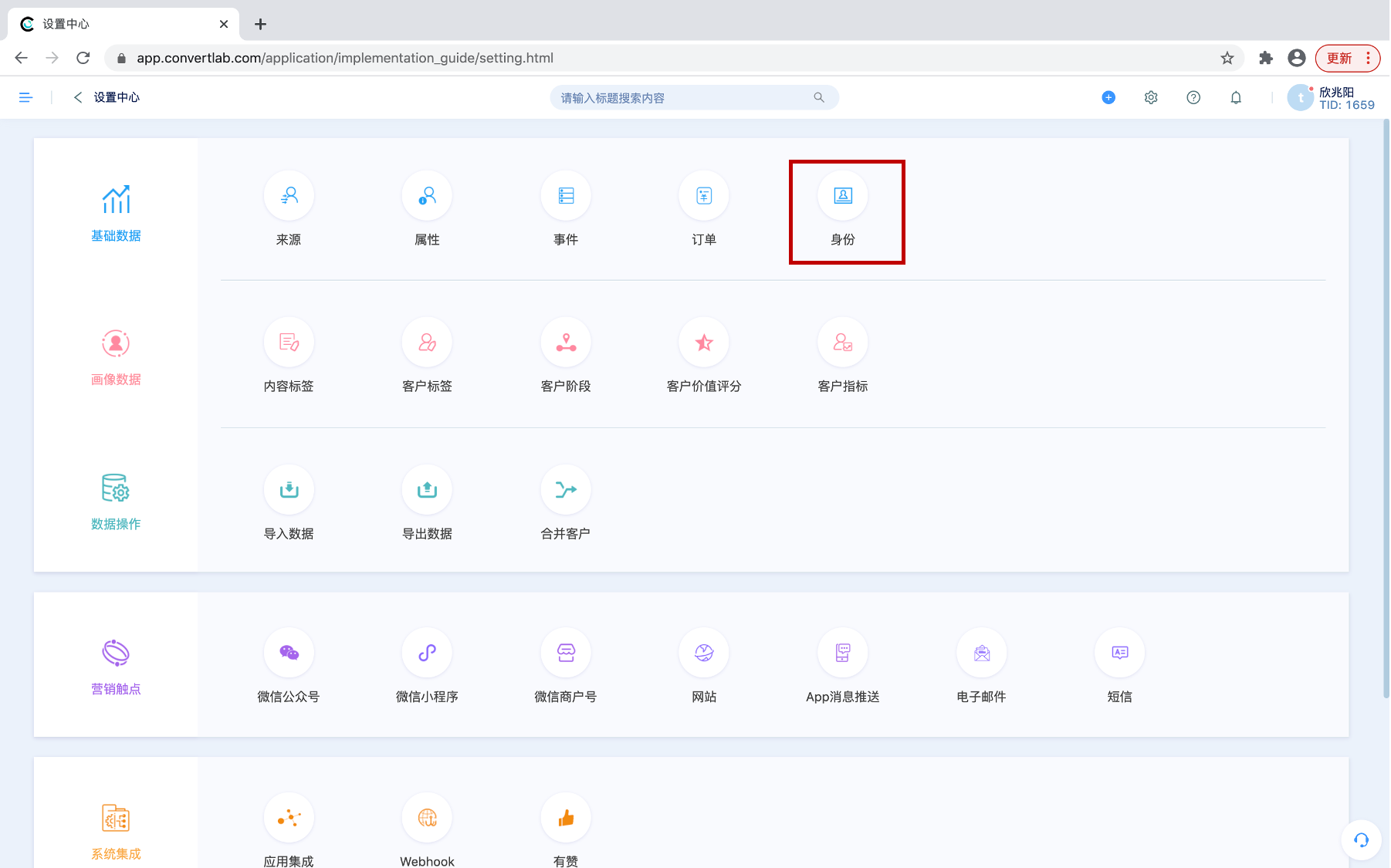
4.2Uniqueness of Identity
Support custom setting whether the identity value is unique
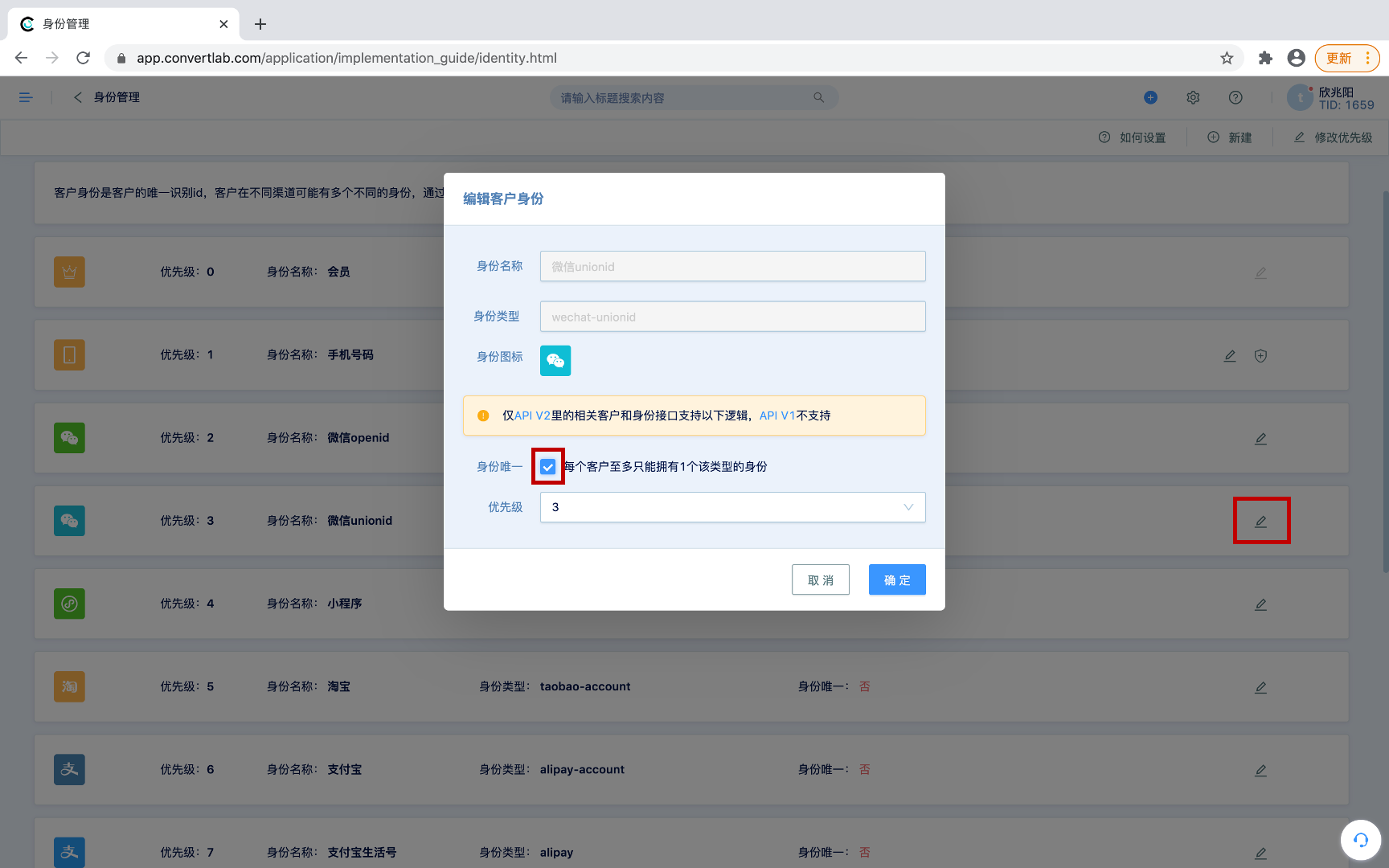
4.2.1Examples of scenarios where the identity value is not unique:
For example, a company has 3 WeChat official accounts, and all the fans of these 3 official accounts are connected to DM Hub. Customer A follows 3 official accounts at the same time. If the identity of the WeChat openid is unique, Fan A will be created as 3 customers based on openid1, openid2, and openid3 respectively in DM Hub. But usually from the perspective of user portrait integrity, we prefer to concentrate all the behaviors of Fan A in the three official accounts to one customer. At this time, we must set the WeChat openid identity to be non-unique (that is, the identity is unique, not checked here.), and then use WeChat unionid to achieve identity matching (refer to what is unionid and the role of unionid).
4.2.2Example of a scenario where the identity value is unique:
First of all, the member id is definitely unique. Therefore, the identity type “id” in the DM Hub is unique by default and cannot be changed. Because a customer can only create one member identity, one-to-many situations are not allowed. Another example is Taobao id, which should be unique as well.
4.3Identity Priority
- dentity priority can be set directly in [Setting Center-Identity], or its processing logic can be preset in the interface.
- dentity priority can be set directly in [Setting Center-Identity], or its processing logic can be preset in the interface.
- When adding or merging customer identities results in identity conflict, priority can be used to resolve the conflict.
4.4The default settings of the system's existing identity
| Identity Name | Priority | Identity Type | Default as Unique | Custom Uniqueness | Custom Priority |
|---|---|---|---|---|---|
| Membership | 0 | membershipId | Yes | X | X |
| Mobile Phone Number | 1 | mobile | No | √ | √ |
| WeChat openid | 2 | No | √ | √ | |
| WeChat unionid | 3 | wechat-unionid | No | √ | √ |
| Mini Program | 4 | applet-wechat | No | √ | √ |
| Taobao | 5 | taobao-account | No | √ | √ |
| Alipay | 6 | alipay-account | No | √ | √ |
| Alipay life account | 7 | alipay | No | √ | √ |
| Enterprise WeChat | 8 | wechatcorp | No | √ | √ |
| Email Address | 9 | No | √ | √ | |
| dmhub | 10 | dmhub | No | √ | √ |
| YouzanID | 11 | cp_extyouzan_identity_userId | No | X | X |
| Enterprise WeChat | 12 | cp_employee_tools_identity_corp | No | X | X |
| MD5 Encripted Identity | 13 | commonMd5 | No | X | √ |
| Tmall Encripted Identity | 14 | tmallMd5 | No | X | √ |
| Jindong Encripted Identity | 15 | jdMd5 | No | X | √ |
4.5What is an encrypted identity
Due to data privacy and security issues, some channels can only provide encrypted mobile phone numbers (such as Tmall, JD members) identities, and encryption methods are also provided. In order to support omni-channel customer data matching and identification, the system will provide clear text obtained from other channels The "mobile phone number" identity is also encrypted in a corresponding way, and can be matched and identified based on ciphertext. (Currently only mobile phone number identity supports encryption)
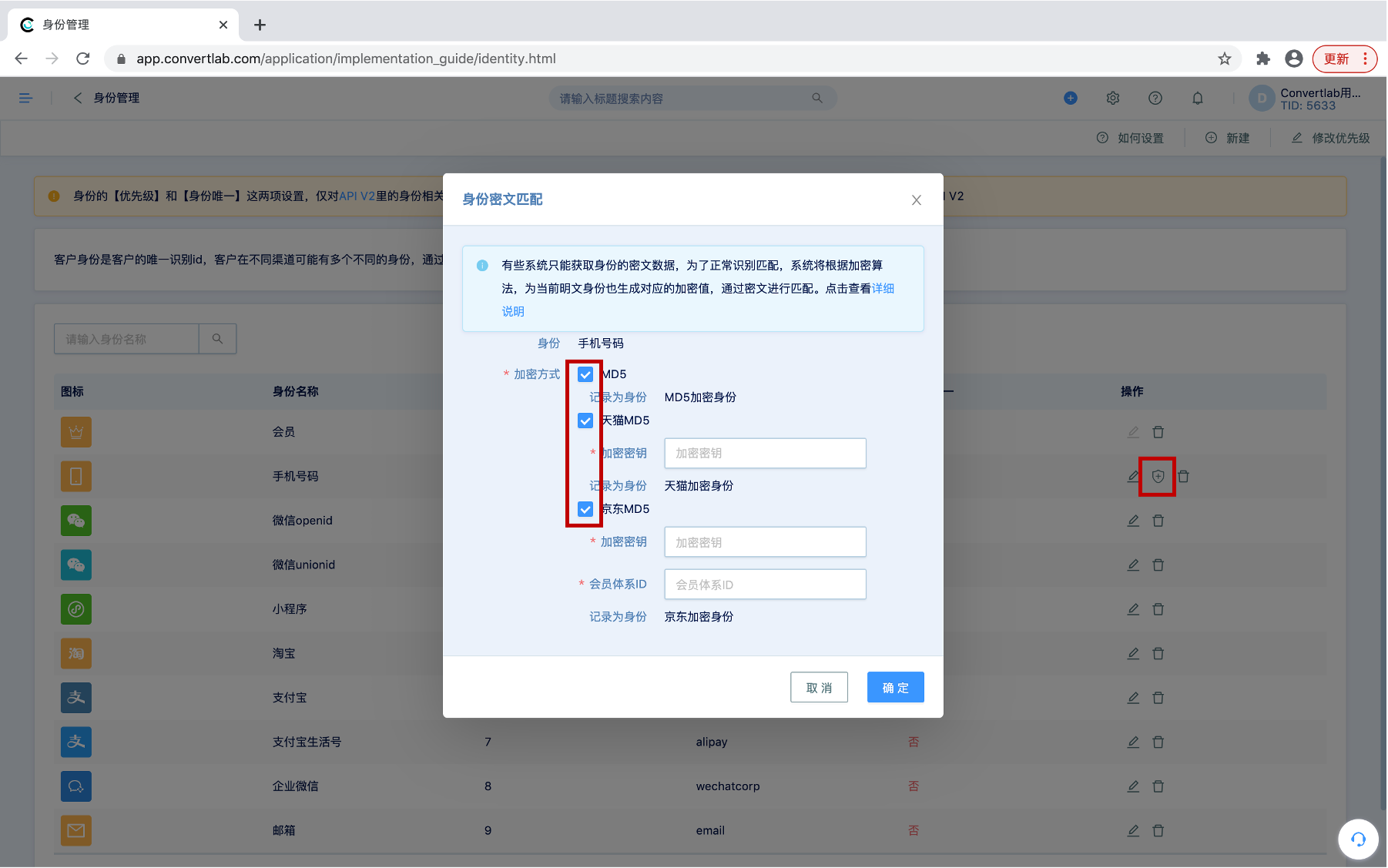
4.6Processing logic of encrypted identity
- • The encryption result of each encryption type will be recorded as a new system identity (these identities are non-unique and cannot be modified)
- • After setting the encryption method of the "mobile phone number" and the identity used to store the encrypted information, the plain text mobile phone number identity that enters the system will automatically generate the corresponding encrypted identity according to the encryption algorithm, and automatically identify and match the customer based on the encrypted identity
- • After modifying the encryption key, the historical encrypted identity will not be automatically updated. You need to delete the original encrypted data and recalculate the new encryption result.
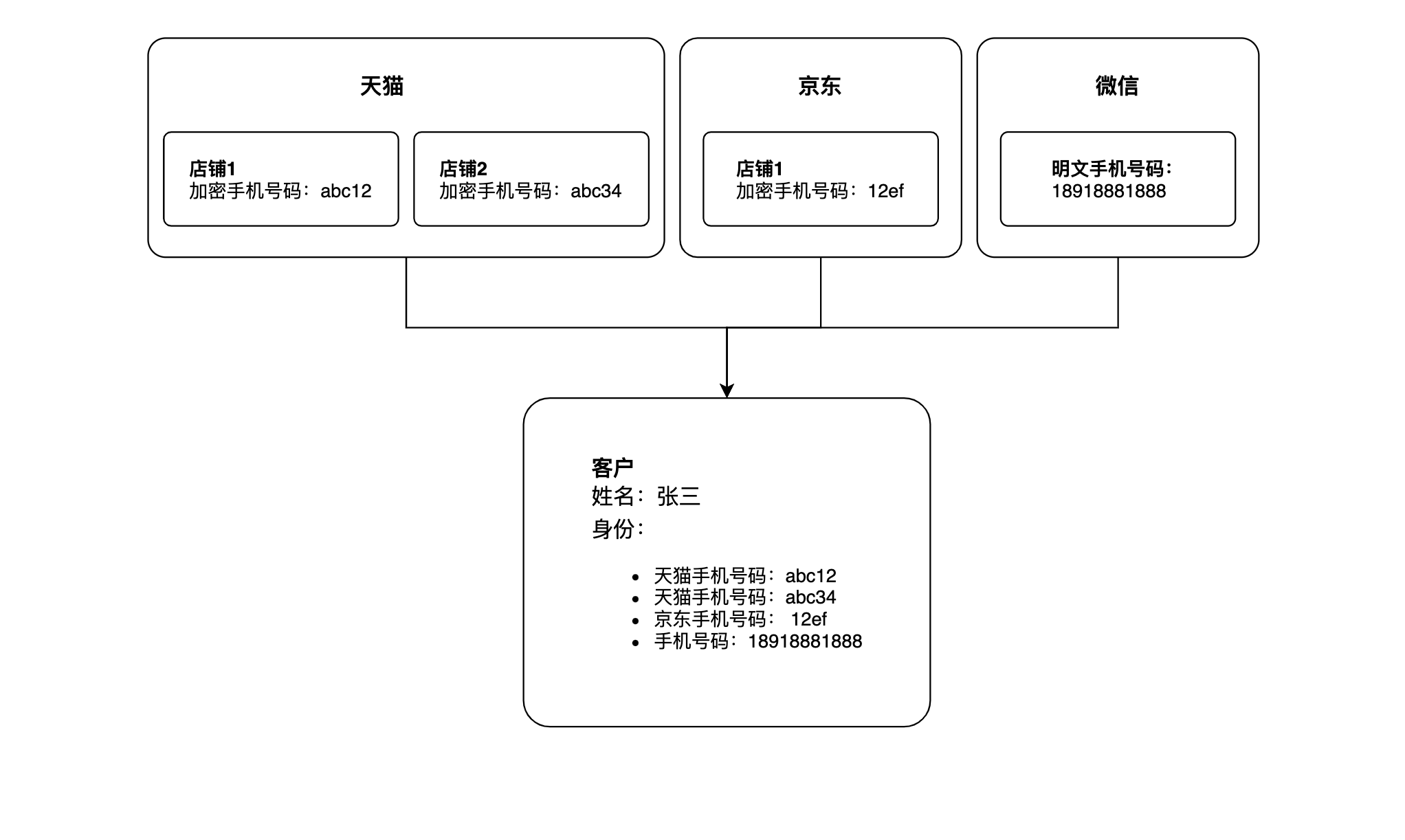
4.7Encryption Rules
| Encryption Type | Encryption Rule | Remarks |
|---|---|---|
| MD 5 Encryption | MD5 Encryption | |
| Tmall MD5 Encryption | MD5(MD5("tmall"+$content+$key)); The encrypted string is 32-bit lowercase. tmall is a fixed character string, key is the mobile phone number encryption key (visible in the member center developer background, test platform), content is the content that needs to be encrypted (here is moblie). | There are multiple stores of the brand, and the encryption keys are different |
| JinDong MD5 Encryption | The encryption rule is to splice the string twice with MD5 encryption (uppercase): Encrypted mobile phone number = MD5 (MD5 (brand secret key + membership system id + user mobile phone number + brand secret key)) | multiple stores of the brand, the brand secret key is the same |
Provide Open API to view various encrypted identity values of mobile phone number identity
5.Merge Customer
First of all, we must clarify two concepts, merger and update.
Merge: Customer merge means that there are already two customers A and B in the system. Because they have some key information (such as mobile phone number, email) that is the same or similar, they can be merged into one customer (provided that these two customers’ identities are not conflict, otherwise the merge fails).
Update: The data passed by the API is matched to a certain customer in the system, and the data is updated to the existing customer in the system.
5.1Scenarios of Auto-Merge
Merger of customers with same Unionid
Scenario: Each fan has a corresponding openid identity in each official account. If you have multiple WeChat official accounts and they are all authorized to bind to DM Hub, when you follow these two official accounts, customers will be created based on oepnid. Example: You have two official accounts A and B. Fan D follows A, and then follows B. In this way, the nicknames are all D in the system, but the identities are openidA and openidB. However, if the two official accounts are bound on the WeChat open platform after the DM Hub is authorized, in addition to the openid identity, there is also a unionid identity, and the unionid in the two official accounts A and B is the same. For customers who are newly following after binding, they will automatically obtain the two identities of uninonid and openid, and when they follow the second official account, unionid will be matched and updated. But for fans created before binding the open platform, will they automatically obtain unionid and merge? Note that the historical fans here will not automatically update the unionid, you must unbind the bound official account and re-authorize to import the fans. If after unbinding, first authorize the public account of A, and then authorize the public account of B, then the original identity of customer B who is openidB will be merged because it has the same unionid as customer A.
Merge description: The merge will be merged in accordance with the standard merger rules, and the merge direction is customer B merged into customer A
Merge customers after submitting the WeChat Page form
Scenario: There is already a customer A with a mobile phone number of 189XXX in the system, who does not have an openid identity, and then customer B pays attention to the official account (a new customer B with openid identity will be created in the system), and then customer B submits a WeChat Page form. The form has a mobile phone number field and the mobile phone number has a verification code requirement (this is a necessary condition for merging). The mobile phone number is also 189XXX. After submission, customer A is merged into B.
Merge description: Customer id will retain customers with openid identity; if there is an identity conflict between A and B (identity conflict refers to two customers having the same identity type through the same channel, except for openid, for example, customer A and customer B have different member IDs ) it will not be merged; if there is no identity conflict, it will be merged, and the customer information will be updated according to the filled-in form content; (Note: Considering of the time required to create and merge customers, in order to ensure the triggering conditions or event judgments of the auto-flow to be executed normally, and the form submission event will be sent out with a delay of several seconds).
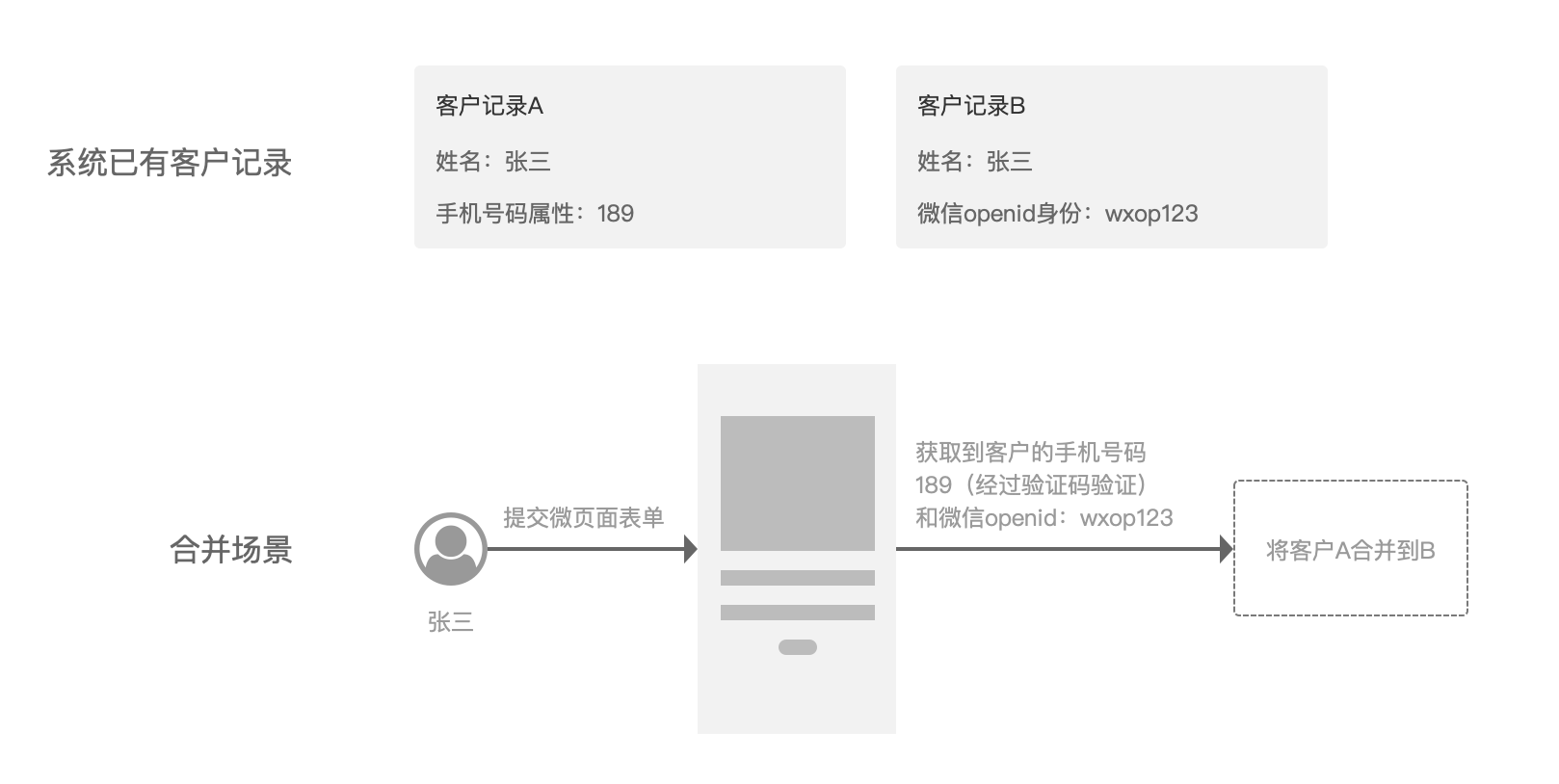
5.2Processing logic of customer merge
In the following descriptions, the order in which customer A is merged into customer B is taken as an example
5.2.1Customer ID processing logic after customer merger:
After the merge, the customer id of customer B will be retained, which can be understood as customer A has been deleted and customer B has been updated. The customer ID of customer A no longer exists in the system. The main impacts are:
- The issuance record of the equity code and the lottery record of the lottery are all related to customer IDs (does not affect the event), and will not be updated to the new ID after the merge
- The customer A customer id may be used in the external system connection, and the customer cannot be queried
5.2.2 Merge logic of customer-related information:
| Customer Information | Merge Rule |
|---|---|
| Group | Keep both of customer A and B (the smart group will recalculate later and determine whether the customer still belongs to the group) |
| Tags | Keep both of customer A and B (the smart and modle tags will recalculate later and determine whether the customer still belongs to the group) |
| Identity | Keep both of customer A and B (if both customers have system’s memberships, merger are not allowed) |
| Order | Keep both of customer A and B |
| Customer Indicators | Keep Customer B |
| Task | Keep both of customer A and B |
| Events | Keep both of customer A and B |
| Goods in Use | Keep both of customer A and B |
The value of the customer properties after the merge is based on customer B by default, and the property value of customer A is taken only when its property value is empty. However, there are exceptions to some properties, as shown in the following table:
| Customer Properties | Merge Rule |
|---|---|
| Provinces, cities, districts and counties | Only when these three property values of customer B are all empty, will the property value of customer A be taken |
| Create time, create method, create from | Use the property value of the customer that was created earlier |
| Source field, Marketing campaign | Use the property value of the customer that was created earlier |
| Customer stage | Use customer property value with further customer stage |
| Membership Status | If A or B is member, then the property remains yes after merge |
5.2.3The impact of customer merge on the custom process
If customer A is in an auto-flow and is in progress when the merger occurs:
- Situation 1: If the customer in the auto-flow does not have customer B, then customer B will replace customer A, and continue to complete the auto-flow
- Situation 2: The customer who is currently in the auto-flow already has customer B, so it will not be processed (that is, customer A has been deleted)
5.3How to deal with customer merge
5.3.1Manual operation in the system
As mentioned above, the system can automatically match customer data through customer identity, but there are still some special scenarios. Considering that data merging may cause some data to be lost, the system cannot accurately perform automatic merging. At this time, users may need to manually merge customers. There are two entrances to merge customers, one is [Setting Center]-[Data Operation]-[Merge Customers]
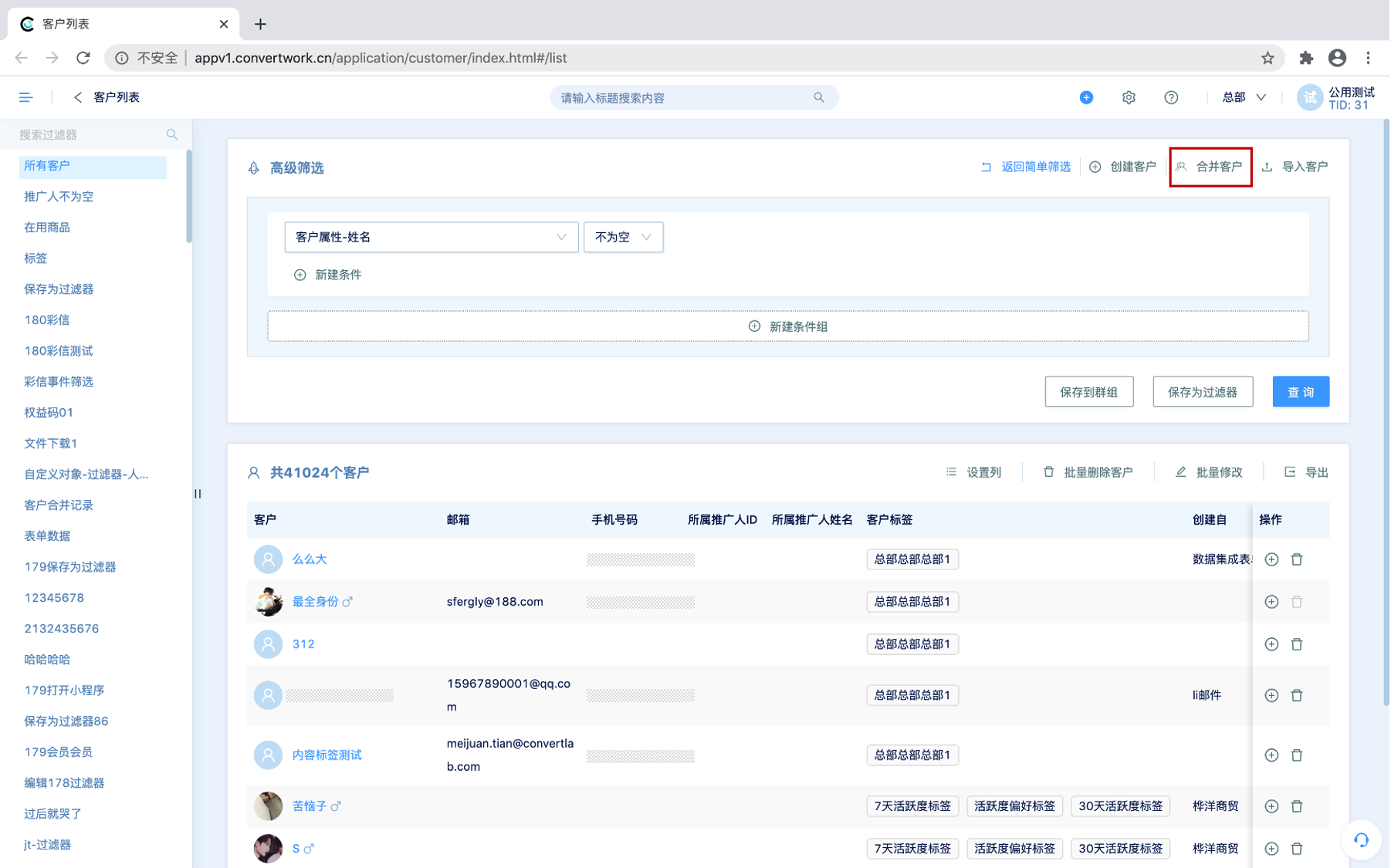
Two function entrances are the same. DM Hub supports merging customers with the same mobile phone number or email properties, select the appropriate merge method.
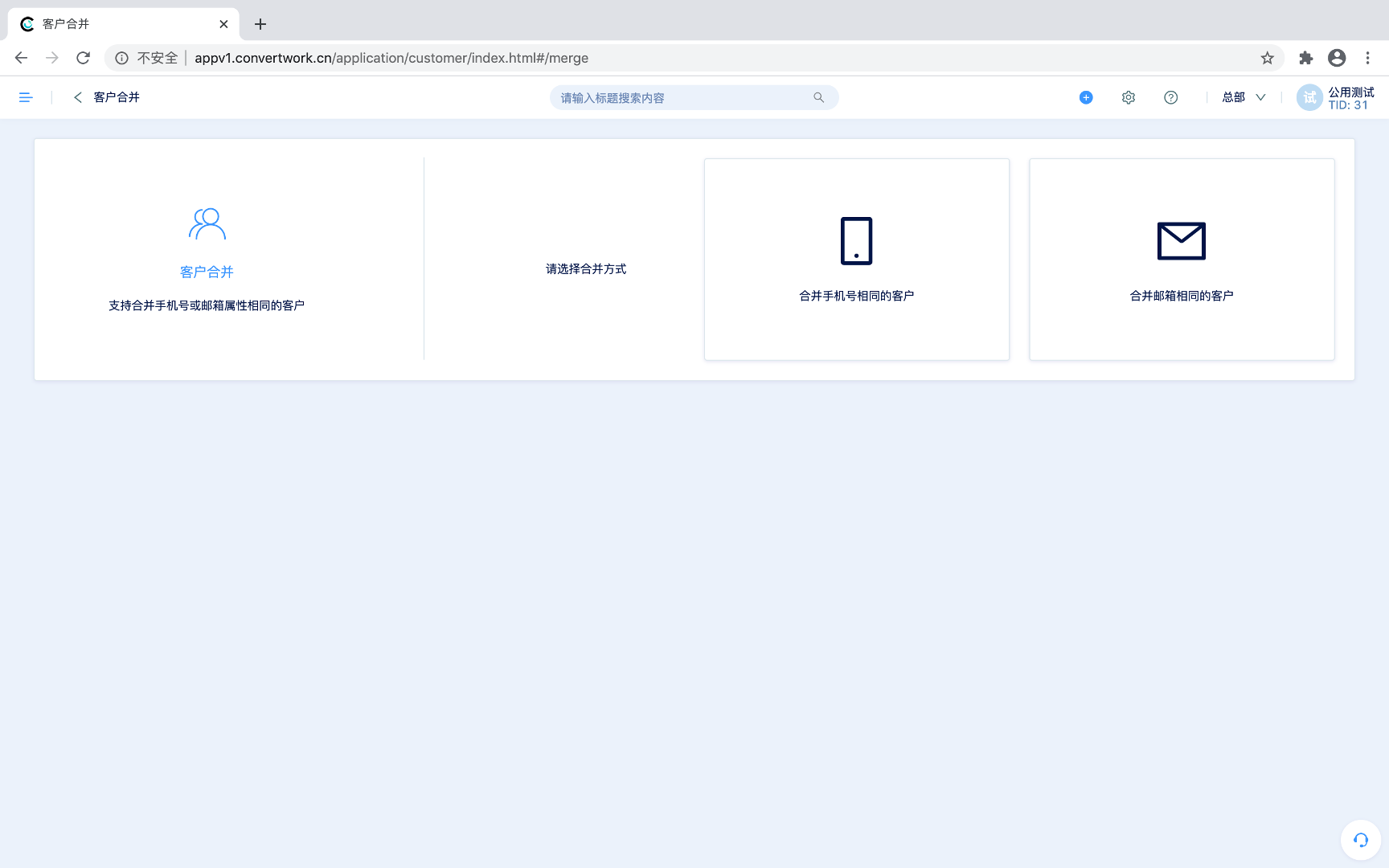
After the selection, the system will start to scan the customers and give the merger opinions, as shown in the figure below:
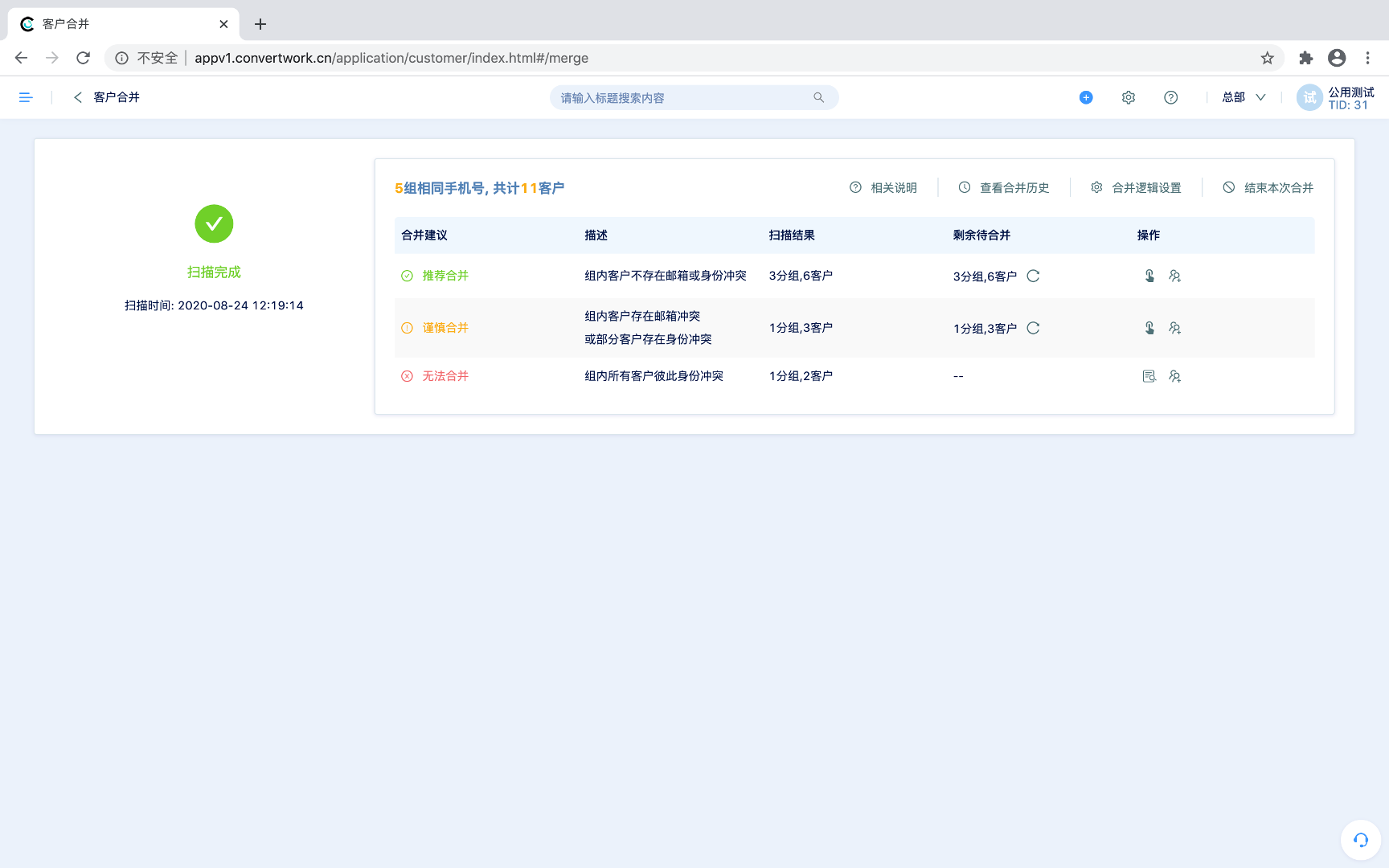
E-mail conflict: E-mail conflict refers to two customers who have the same mobile phone number properties, but their email address are inconsistent. Email is the key information for contacting customers. If there is a conflict, user needs to carefully choose which mailbox to keep
Identity conflict: Identity conflict means that two customers have the same mobile phone number property and the same identity type, and the identity ids of this identity type are inconsistent.
Based on this, DM Hub gave the following merger opinions:
Recommended merge: There is no email address or identity conflict for customers in the group.
Merge carefully: There are email address conflicts among customers in the group or identity conflicts with some customers. There is a email address conflict in the group, so you need to choose which email address to keep after the merge when merging. Some customers in the group have conflicting identities, so customers without identity conflicts can still choose to merge.
Unable to merge:all customers in the group conflict with each other.
We choose "Recommended Merge" to carry out the merge operation. Each block is a group of customers to be merged. You can select the customers to be merged through the checkbox on the left. You can also directly click the properties of the customers you want to keep after the merge and selectting the properties will show a green "√" on the right.
There are two check boxes at the top right:
Display customer identity: After checking, the customer identity will be displayed on the right side of the table
Display the same property value: After checking, the customer properties with the same value in this group will also be displayed.
Batch merge
For all groups of "Recommended Merge" after scanning, the system supports one-click batch merging. Click the button in the upper right corner to perform batch merging.
Note: When multiple customers are merged, the customer id will give priority to those with membership identity, then those with WeChat identity, and then customers with other identities.
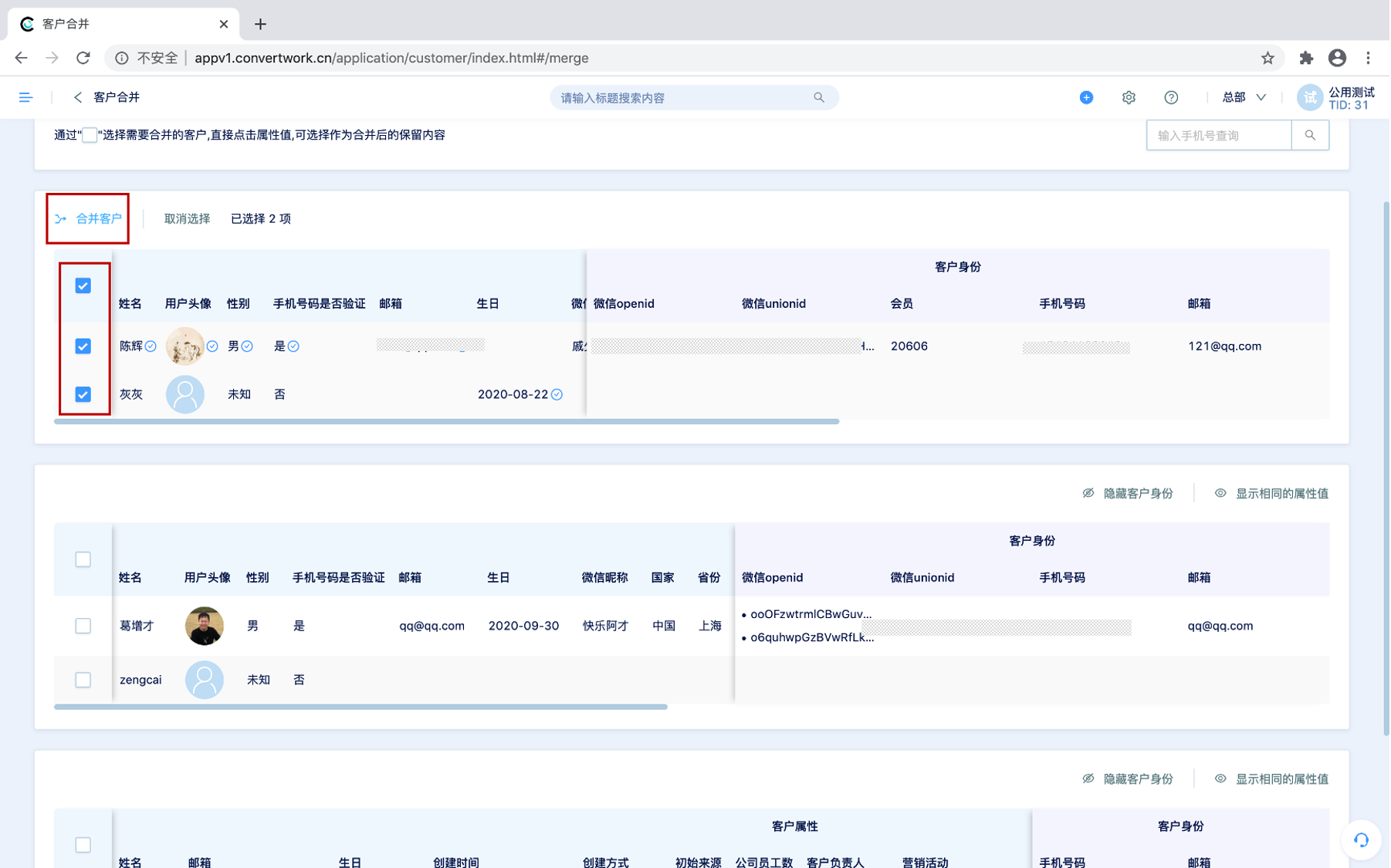
5.3.2 Merge Customer Through API
Refer to Document: Merge Customer
6.API-Multi Identity create customer
6.1description for API multi-identity to create customer
Refer to document:Multi-identity to create customer
6.2 Processing Strategy for multi-identity creation
When using API multi-identity to create a customer, you can attach multiple customer identity information. According to different strategies, DM Hub will create, update or merge customers. Specific steps are as follows:
- According to the provided customer identity, DM Hub first uses the "target customer strategy" to find target customers
- After finding the target customer, DM Hub will decide whether to merge multiple customers according to the "customer merge strategy"
- If the identities do not conflict, DM Hub will associate the identities of the unassociated customers with the target customers
- DM Hub updates the customer field provided by the API to the target customer
Strategy for Creating Customer
| Strategy Type | Strategy Name | Strategy Action |
|---|---|---|
| Identity Uniqueness Strategy | Identity Uniqueness Strategy | 在DM Set in the DM Hub setting center; the identity of the external application plug-in, the plug-in can set the uniqueness of the identity |
| Identity Priority Strategy) | Default strategy for system identity priority (V2) | Use system’s default identity priority |
| Custom Identity Priority Policy (v1) | Prioritize the order of the identities provided by the API | |
| Target Customer Strategy | Identity First | Find customers in the order of identity priority: If the customer can be found with the highest priority identity, the customer is the target customer, otherwise, the next highest priority identity is used to find the customer. If the customer is found: 1. If a higher identity is added to the customer, there will be a conflict, then the system will use the next priority identity to search; 2. If there is no conflict when adding an identity the customer will be regarded as the target customer and will be compared with the current identity. (If identity conflicts, then add will fail). If the last matched customer will bring an identity conflict, create a new customer with the highest priority identity and set the new customer as the target customer. Then add other identities. |
| Customer First (v1, v2) | Find customers in the order of identity priority. The first customer found is the target customer (without checking for high-priority identity conflict issues). If no matching customer is found, a new customer will be created with the highest priority and adds other identities for the target customer. | |
| Customer Merge Strategy(autoMerge) | Don’t merge default (false)strategy (v1, v2) | If multiple customers are found based on the multiple customer identities provided, the target customer will be found according to the "target customer strategy" and the target customer field will be updated. Customers are not merged. |
| Merge customer (true) | If multiple customers are found based on the multiple customer identities provided, and there is no identity uniqueness conflict between multiple customers, the target customer will be found according to the "target customer strategy", the other customers will be merged into the target customer first, and then the target customer will be updated. |
High priority identity first (not merged)
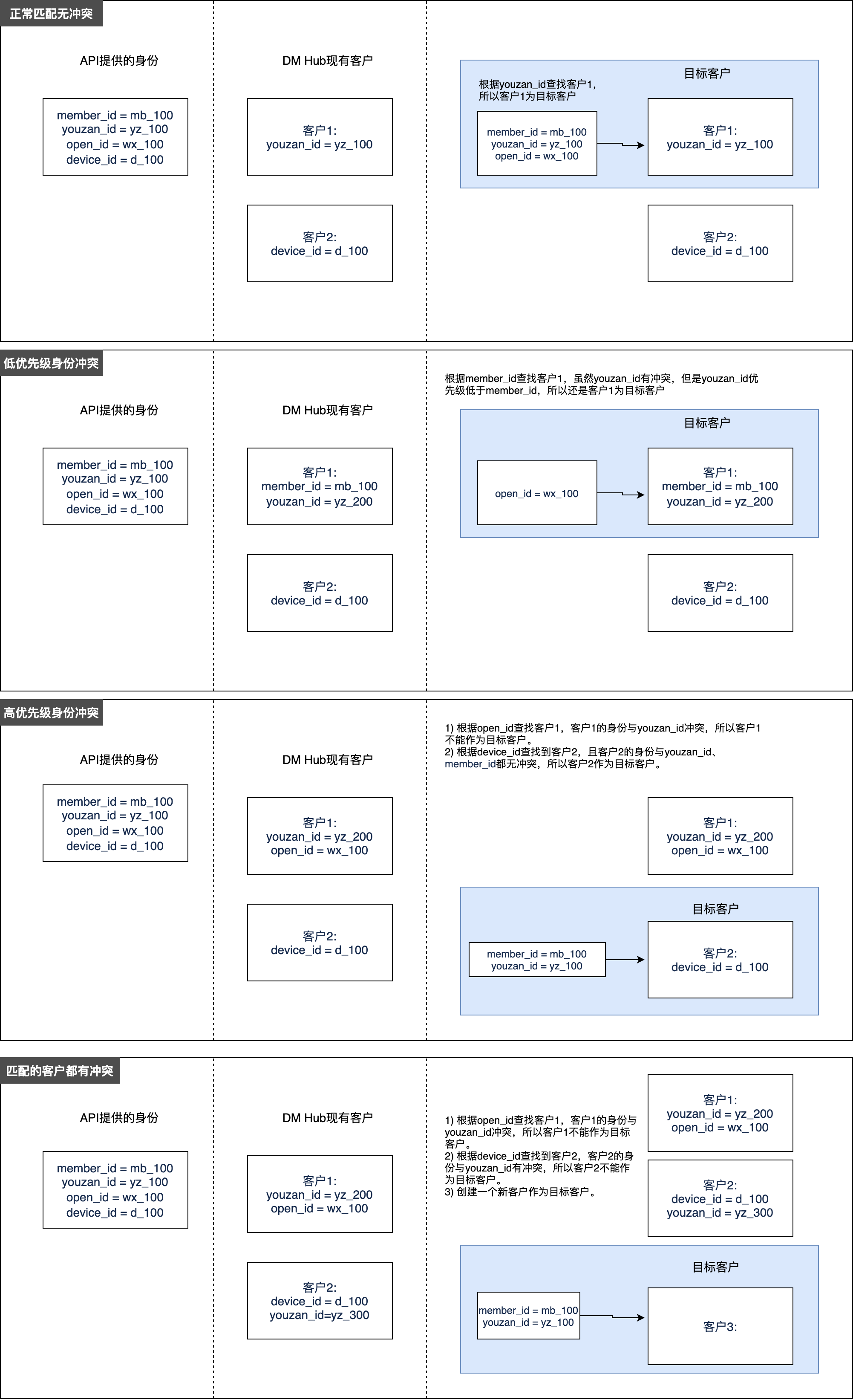
High priority identity first (merged)
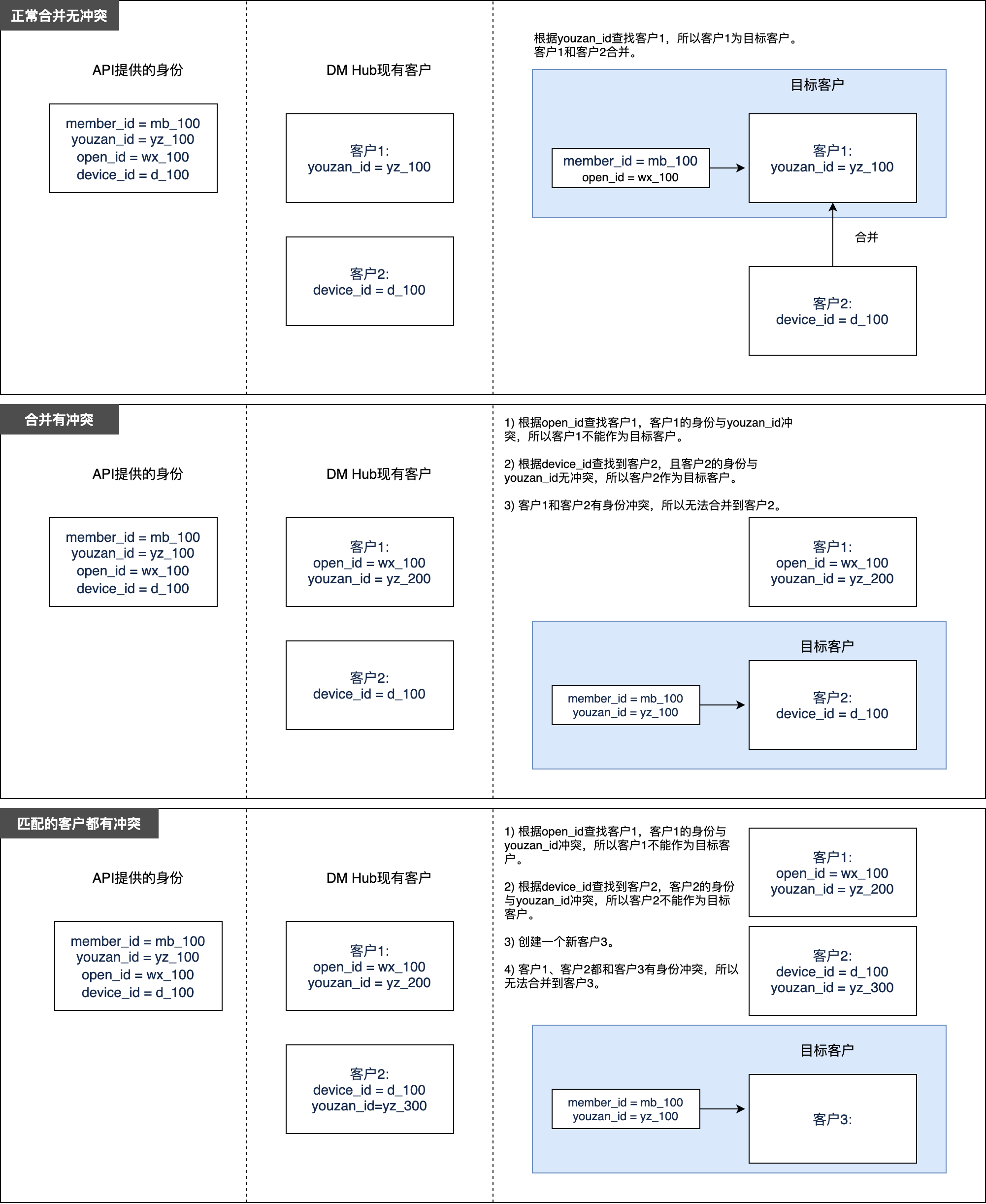
Customer first priority (not merged)
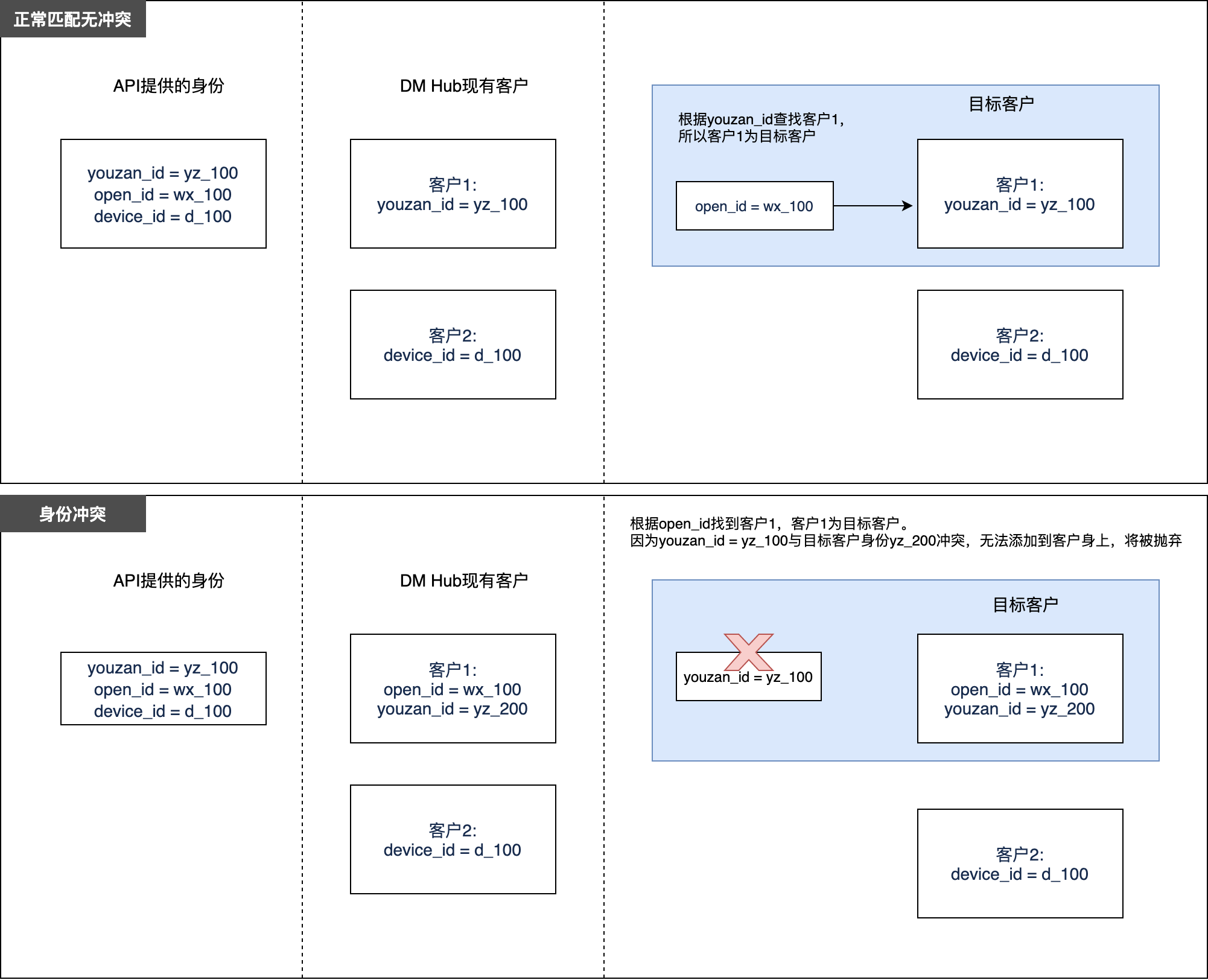
Customer first priority (merged)
